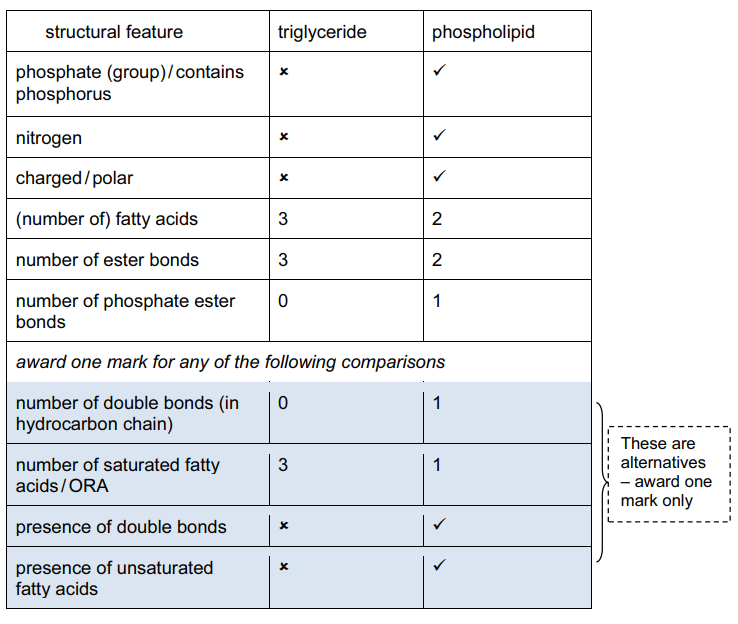Question
Fig. 1.1 is a drawing made from an electron micrograph of a mammalian liver cell.
(a) Complete the table by naming the structures B to G and stating one function of each.
The first one (A) has been completed for you.
(b) As shown in Fig. 1.1, liver cells contain many storage granules of glycogen.
Describe the molecular structure of glycogen and explain how this structure makes it
suitable for storage.
Answer/Explanation
Answer:
(a) one mark per row
penalise once for stated ecf and then mark to max 4
(b) max 3 if only structure or only explanations given
polysaccharide ;
chains of α-glucose (residues) ; only need α once
α1–4 glycosidic bonds / links ;
branches ;
(because of) α 1–6 glycosidic bonds ; only need glycosidic once
idea that many ‘ends’ to easily, add / remove, glucose ;
compact / AW ;
insoluble ;
will not affect, water potential / ψ ; AW
AVP ;
Question
Fig. 5.1 shows a diagram of the molecular structures of tristearin (a triglyceride) and phosphatidylcholine (a phospholipid).

(a) Table 5.1 shows a structural difference between the two molecules shown in Fig. 5.1.
Complete Table 5.1 with two further structural differences other than in numbers of different types of atoms.[2]

(b) Cells in the pancreas secrete enzymes, such as amylase and trypsin, into a duct.
The enzymes are packaged in vesicles so that they can be exported from these cells as shown in Fig. 5.2.

With reference to Fig. 5.2, explain how enzymes that are secreted by cells in the pancreas are packaged into vesicles and exported.[4]
(c) Water has many significant roles to play in cells and living organisms.
Complete Table 5.2 below by stating the property of water that allows each of the following to take place.[3]

[Total: 9]
Answer/Explanation
Ans:
5 (a)

(b) answer may be phrased in the context of amylase/ trypsin ignore anything before Golgi, e.g. shuttle vesicles from RER
1 vesicles, form from/ ‘pinch off’, Golgi (apparatus /body / complex) ;
2 vesicles moves, through cytoplasm/ to cell (surface) or plasma membrane ;
3 role of cytoskeleton/ microtubules in movement of vesicles ;
4 energy /ATP, is required (movement of vesicles / fusion with membrane) ;
5 vesicle fuses with/AW, cell (surface)/ plasma, membrane ;
I bind/ attach A join/ merge/ becomes part of
6 exocytosis / vesicle ‘opens up’ so that enzyme molecules are released ;
7 ref to fluid nature of, membranes / phospholipid bilayer, that makes this possible ;
(c)

Question
Starch is composed of two polysaccharides, amylose and amylopectin.
Fig. 3.1 shows a molecule of α-glucose before being added to the end of a molecule of amylose.

(a) (i) Complete Fig. 3.1 to show how a molecule of α-glucose is added to the amylose. [3]
(ii) Name the bond that forms between glucose molecules in polysaccharides, such as amylose.[1]
(b) Glycogen and cellulose are two other polysaccharides.
Complete Table 3.1 to compare glycogen and cellulose with amylose.[3]

(c) Type 2 diabetes (insulin-independent diabetes) is a non-infectious disease.
If not treated, this disease is characterised by large fluctuations in the concentration of glucose in the blood.
Maltase is an enzyme that completes the digestion of starch in humans. Molecules of maltase are bound to the microvilli of epithelial cells in the small intestine.
Ascorbase is a drug used in the treatment of type 2 diabetes. Molecules of ascorbase have a very similar shape to that of the substrate for maltase.
(i) Explain how ascorbase acts to inhibit these membrane-bound enzymes. [3]
(ii) Suggest why ascorbase can be used to treat people who have type 2 diabetes. [2] [Total: 12]
Answer/Explanation
Ans:
3 (a) (i) –H and –OH indicated ; A –OH on end of amylose and –H on alpha glucose
water eliminated/ condensation ; A dehydration
oxygen bridge/glycosidic bond, drawn between C1 and C4 ;

If the whole glucose molecule and/or the end of the amylose molecule has not been drawn, then only award mp3 if C1 and C4 are indicated in some way, e.g. by numbering them or putting in the hydrogens.
(ii) (1,4/1,6) glycosidic ; A glucosidic A phonetic spelling of glycosidic
(b) 
(c) (i) maltase and maltose must be correctly referenced
ignore references to reversible/irreversible
(ascorbase) binds to/ fits into/ enters active site ;
complementary (shape) to active site ;
so substrate/ maltose, cannot enter/ cannot bind ;
A no/few, ES complex
A prevents formation of ES complexes
A ascorbase forms enzyme inhibitor complex
competes with substrate / competitive inhibition ;
slows the (rate of), digestion/ hydrolysis / breakdown, of maltose ;
R ‘stops the reaction’
R if in context of starch
alternative answer if candidates assume ascorbase is an enzyme:
ascorbase, breaks down/ digests / hydrolyses, maltase ;
A ascorbase destroys the active site of maltase
so no enzymes to digests maltose ;
slows / stops, reaction/digestion/hydrolysis / breakdown, of maltose ;
(ii) inhibits / slows down/ prevents, breakdown/(catalysing) hydrolysis / digestion, of maltose (to glucose) ; I starch
less glucose is absorbed/ passes across membranes /enters blood ;
